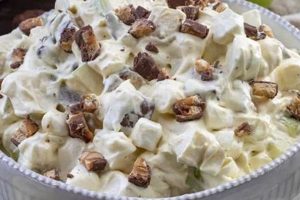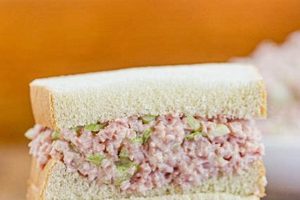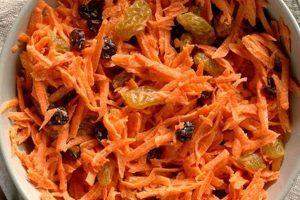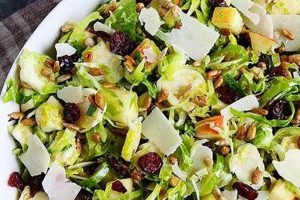Dishes featuring chilled asparagus as the primary ingredient offer a refreshing and nutritious option, often incorporating complementary vegetables, herbs, cheeses, and dressings. A classic example combines blanched asparagus spears with vinaigrette, crumbled feta cheese, and thinly sliced red onion.
These salads provide a light yet satisfying meal or side dish, particularly suitable for warmer weather. Asparagus is a good source of vitamins K and C, folate, and fiber. Serving it cold preserves these nutrients while offering a crisp, contrasting texture to other salad components. The versatility of asparagus allows for a range of flavor profiles, from bright citrus dressings to creamy, savory sauces, evolving from simple preparations found in historical cookbooks to modern, innovative culinary creations.
This discussion will further explore variations on this culinary theme, addressing topics such as ingredient selection, preparation techniques, dressing options, and complementary pairings.
Tips for Preparing Cold Asparagus Salad
Achieving optimal flavor and texture in a cold asparagus salad requires attention to detail throughout the preparation process. The following tips offer guidance for creating a successful dish.
Tip 1: Selecting Asparagus: Opt for firm, bright green spears with tightly closed tips. Avoid limp or dry asparagus. Thicker spears are preferable for grilling or roasting, while thinner spears work well for raw preparations.
Tip 2: Proper Blanching: Blanching asparagus ensures a vibrant green color and tender-crisp texture. Briefly submerge the spears in boiling water, then immediately transfer them to an ice bath to stop the cooking process.
Tip 3: Dressing Considerations: The dressing should complement the asparagus without overpowering its delicate flavor. Light vinaigrettes, lemon juice, or creamy dressings based on yogurt or buttermilk are excellent choices.
Tip 4: Enhancing Flavor with Herbs: Fresh herbs like chives, tarragon, mint, or parsley add depth and complexity. Incorporate them just before serving to maximize their aroma and flavor.
Tip 5: Complementary Ingredients: Consider adding other vegetables, such as cherry tomatoes, bell peppers, or radishes. Crumbled cheeses like feta, goat cheese, or parmesan provide a salty, savory counterpoint.
Tip 6: Texture Variation: Toasted nuts or seeds, such as slivered almonds, pine nuts, or sunflower seeds, offer a satisfying crunch and enhance the overall textural experience.
Tip 7: Chilling Time: Allow the salad to chill for at least 30 minutes before serving. This allows the flavors to meld and the asparagus to absorb the dressing.
By following these guidelines, one can create a cold asparagus salad that is both visually appealing and delicious, showcasing the fresh, vibrant flavors of the season.
These preparation techniques contribute to a flavorful and enjoyable culinary experience, demonstrating the versatility of asparagus as a key salad ingredient.
1. Fresh Asparagus
Fresh asparagus serves as the cornerstone of high-quality cold asparagus salad recipes. The inherent tenderness and subtle sweetness of freshly harvested asparagus contribute significantly to the overall flavor profile and textural appeal of these dishes. Using fresh asparagus, as opposed to frozen or canned varieties, results in a brighter, more vibrant flavor and a pleasant, crisp-tender texture. This difference significantly impacts the final product; a salad made with fresh asparagus offers a superior sensory experience. For instance, a cold asparagus salad featuring freshly picked spears tossed with a light vinaigrette and crumbled goat cheese showcases the vegetable’s delicate flavor and crisp texture, while using frozen asparagus in the same recipe would yield a less vibrant and potentially mushy outcome.
The quality of fresh asparagus directly influences the success of cold asparagus salad recipes. Factors such as proper storage and handling play a crucial role in preserving the asparagus’s freshness. Ideally, asparagus should be refrigerated and used within a few days of purchase. When selecting asparagus, look for firm stalks with tightly closed tips, free from signs of wilting or discoloration. These indicators signify optimal freshness and ensure the best possible flavor and texture in the finished salad. Furthermore, different varieties of asparagus, such as purple or white asparagus, can introduce unique flavors and visual appeal to cold salads, expanding culinary possibilities. Proper preparation techniques, including trimming the ends and blanching or grilling the spears, further enhance the asparagus’s natural characteristics and prepare it for incorporation into a cold salad. For example, grilling asparagus imparts a smoky char that complements robust flavors like balsamic vinegar and Parmesan cheese, offering a delicious contrast to the traditional fresh asparagus salad profile.
Prioritizing fresh, high-quality asparagus is paramount for achieving exceptional cold asparagus salad recipes. This emphasis on freshness not only elevates the taste and texture of the dish but also contributes to a more vibrant and appealing presentation. While other ingredients play supporting roles, the quality of the asparagus remains a defining factor in the overall culinary experience. Overlooking the importance of fresh asparagus can compromise the salad’s delicate balance of flavors and textures, leading to a less satisfying result. Chefs and home cooks alike should prioritize sourcing and properly handling fresh asparagus to ensure the creation of flavorful, visually appealing, and texturally satisfying cold asparagus salads.
2. Complementary Flavors
The success of cold asparagus salad recipes hinges significantly on the thoughtful integration of complementary flavors. Asparagus possesses a unique, subtly sweet, and slightly grassy flavor profile that provides a versatile canvas for culinary creativity. Strategic pairing with other ingredients enhances the asparagus, creating a balanced and harmonious flavor experience.
- Acidity:
Balancing the inherent sweetness of asparagus with acidic elements is crucial. Citrus fruits, such as lemon or grapefruit, offer a bright, refreshing counterpoint. Vinegars, including white wine vinegar, balsamic vinegar, or rice vinegar, introduce complexity and depth. The sharpness of these acidic components cuts through the richness of other ingredients, preventing the salad from becoming overly sweet or heavy. For example, a lemon vinaigrette brightens a salad with fresh asparagus, feta cheese, and olives, while a balsamic glaze adds a touch of sweetness and tang to grilled asparagus and prosciutto.
- Savory Notes:
Incorporating savory elements provides depth and complexity to cold asparagus salads. Cheese, such as crumbled feta, shaved Parmesan, or creamy goat cheese, introduces salty, umami notes. Cured meats, like prosciutto or pancetta, offer a rich, savory dimension. These savory components create a counterpoint to the sweetness of the asparagus, adding layers of flavor and preventing the salad from tasting bland. A salad with asparagus, goat cheese, and toasted walnuts exemplifies this balance, while a combination of asparagus, prosciutto, and balsamic vinegar demonstrates a richer, more intense flavor profile.
- Herbaceous Aromas:
Fresh herbs contribute a vibrant, aromatic dimension to cold asparagus salads. Chives, tarragon, mint, dill, and parsley all offer distinct flavor profiles that complement asparagus. These herbs introduce layers of complexity, enhancing the overall sensory experience. The choice of herbs can significantly influence the final flavor profile of the salad, from the bright, peppery notes of chives to the subtle anise flavor of tarragon. For instance, a salad with asparagus, lemon vinaigrette, and fresh dill offers a light, refreshing taste, whereas a combination of asparagus, feta cheese, and mint creates a more herbaceous and slightly sweet profile.
- Textural Contrasts:
While not strictly a flavor component, texture plays a vital role in the overall experience of a cold asparagus salad. Incorporating crunchy elements, such as toasted nuts, seeds, or croutons, provides a pleasing contrast to the tender asparagus spears. This textural interplay adds another layer of complexity and keeps the salad from feeling monotonous. A salad featuring asparagus, crumbled goat cheese, and toasted almonds provides a delightful textural contrast, while a combination of asparagus, shaved Parmesan, and toasted pine nuts offers a different yet equally satisfying textural experience.
The careful consideration of complementary flavors is essential for creating well-balanced and delicious cold asparagus salads. The interplay of acidity, savory notes, herbaceous aromas, and textural contrasts elevates the simple asparagus spear into a complex and satisfying culinary creation. These flavor combinations create a symphony of tastes and textures, transforming a basic salad into a memorable dish. By understanding the nuances of these complementary flavors, one can craft cold asparagus salads that are not only delicious but also showcase the versatility and culinary potential of this remarkable vegetable.
3. Balanced Textures
Balanced textures are essential for creating a dynamic and satisfying cold asparagus salad. Asparagus, whether raw, blanched, or grilled, offers a naturally tender-crisp texture. However, relying solely on this single texture can result in a monotonous eating experience. Incorporating contrasting textures elevates the salad, creating a more engaging and enjoyable culinary experience. This textural interplay adds depth and complexity, preventing the salad from feeling one-dimensional. For instance, a salad composed solely of blanched asparagus, while nutritious, might lack textural excitement. The addition of toasted slivered almonds immediately introduces a contrasting crunch, transforming the sensory experience.
Several ingredients can contribute to textural balance in cold asparagus salad recipes. Toasted nuts, such as almonds, walnuts, or pine nuts, offer a satisfying crunch. Seeds, like sunflower or pumpkin seeds, provide a similar effect. Croutons, whether homemade or store-bought, introduce a crisp, airy element. Even textural contrasts within the vegetable components can enhance the salad. Combining asparagus with other vegetables, such as diced bell peppers, sliced radishes, or halved cherry tomatoes, introduces subtle textural variations. The crispness of raw vegetables juxtaposed against the tender asparagus creates a more dynamic and interesting salad. Similarly, incorporating a creamy element, like crumbled goat cheese or feta, alongside crunchy components and tender asparagus creates a multifaceted textural experience. A salad with grilled asparagus, crumbled goat cheese, toasted walnuts, and halved cherry tomatoes exemplifies this balanced approach.
The impact of balanced textures extends beyond mere sensory enjoyment. Textural contrast contributes to a more satisfying and memorable dining experience. A well-balanced salad offers a complex interplay of textures that stimulate the palate and enhance the perception of flavors. This interplay encourages mindful eating and increases overall enjoyment. Furthermore, the inclusion of crunchy elements can contribute to perceived freshness, enhancing the overall impression of the dish. Failure to consider textural balance can result in a salad that, while potentially flavorful, falls short in terms of overall satisfaction. Chefs and home cooks should prioritize achieving a harmonious balance of textures to elevate cold asparagus salad recipes from simple to exceptional.
4. Vinaigrettes and Dressings
Vinaigrettes and dressings play a crucial role in cold asparagus salad recipes, acting as a unifying element that binds the individual components together. The right dressing enhances the natural flavors of the asparagus and other ingredients while contributing to the overall balance and complexity of the dish. A poorly chosen or overly heavy dressing can mask the delicate flavor of the asparagus, while a well-crafted vinaigrette can elevate the entire salad.
- Classic Vinaigrettes:
Classic vinaigrettes, typically composed of oil, vinegar, and seasonings, offer a light and refreshing counterpoint to the tender asparagus. A simple lemon vinaigrette, made with fresh lemon juice, olive oil, salt, and pepper, brightens the asparagus and other vegetables. Variations incorporating Dijon mustard, minced shallots, or herbs like chives or tarragon add depth and complexity. These vinaigrettes allow the natural flavors of the asparagus to shine through while providing a subtle tang.
- Creamy Dressings:
Creamy dressings, often based on yogurt, buttermilk, or mayonnaise, provide a richer, more decadent counterpoint to the asparagus. A Greek yogurt dressing, seasoned with fresh herbs and a touch of lemon juice, offers a tangy, creamy complement. Alternatively, a buttermilk-based ranch dressing, incorporating fresh dill and chives, creates a classic pairing. These creamy dressings coat the asparagus, adding a luxurious texture and enhancing the overall richness of the salad.
- Flavor-Infused Oils:
Flavor-infused oils offer a simple yet effective way to elevate vinaigrettes and dressings. Infusing olive oil with herbs, spices, or citrus zest adds depth and complexity. For example, rosemary-infused olive oil in a lemon vinaigrette complements grilled asparagus beautifully. Similarly, chili-infused oil adds a subtle heat to a creamy avocado dressing. These infused oils contribute unique flavor profiles that enhance the overall character of the salad.
- Balancing Acidity and Richness:
The balance of acidity and richness in a dressing is critical for a successful cold asparagus salad. Too much acidity can overwhelm the delicate asparagus flavor, while excessive richness can make the salad heavy and cloying. A well-balanced dressing complements the asparagus and other ingredients without masking their flavors. For example, a lemon vinaigrette balanced with a touch of honey provides both brightness and subtle sweetness, while a creamy goat cheese dressing benefits from a squeeze of fresh lemon juice to cut through the richness. Careful consideration of this balance ensures a harmonious and flavorful salad.
The choice of vinaigrette or dressing significantly impacts the overall flavor profile and enjoyment of a cold asparagus salad. By considering the various options and understanding the interplay of flavors and textures, one can create a dressing that perfectly complements the asparagus and other ingredients, transforming a simple salad into a culinary masterpiece. Whether opting for a light and tangy vinaigrette or a rich and creamy dressing, the careful selection and preparation of this crucial component elevates the cold asparagus salad from ordinary to extraordinary.
5. Proper Chilling
Proper chilling is a critical step in preparing cold asparagus salad recipes, significantly impacting both food safety and the final sensory experience. Chilling not only inhibits bacterial growth but also allows flavors to meld and enhances the desirable crisp-tender texture of asparagus. Neglecting this step can compromise both the safety and enjoyment of the dish.
- Food Safety:
Chilling prepared asparagus promptly after cooking or blanching inhibits the growth of harmful bacteria. Maintaining a temperature below 40F (4C) is crucial for preventing bacterial proliferation. This is particularly important for salads containing potentially hazardous ingredients like mayonnaise-based dressings. Proper chilling safeguards against foodborne illnesses and ensures the salad remains safe for consumption.
- Flavor Development:
Chilling allows the flavors of the various salad components to meld and harmonize. This is especially beneficial when using vinaigrettes or dressings, as the chilling period allows the asparagus and other ingredients to absorb the flavors more fully. The result is a more cohesive and balanced flavor profile. For example, a lemon-herb vinaigrette will more effectively permeate the asparagus spears during chilling, leading to a more pronounced and enjoyable flavor experience.
- Texture Enhancement:
Chilling enhances the desirable crisp-tender texture of asparagus, particularly after blanching or grilling. The cold temperature firms the asparagus spears, creating a more pleasant mouthfeel. This contrasts with salads served at room temperature, where the asparagus may become limp and less appealing. The chilling process contributes to a more refreshing and satisfying textural experience.
- Presentation and Serving:
A properly chilled salad presents more appealingly and offers a more refreshing dining experience, especially during warmer weather. Serving a cold asparagus salad at the ideal temperature enhances the perception of freshness and vibrancy. This contributes to a more enjoyable and satisfying meal. Furthermore, attention to chilling demonstrates culinary care and attention to detail.
Proper chilling is integral to successful cold asparagus salad recipes. It ensures food safety, enhances flavor development, improves texture, and elevates the overall presentation and dining experience. This seemingly simple step significantly impacts the final product, demonstrating a commitment to both culinary excellence and consumer well-being. Overlooking proper chilling can compromise the quality and safety of the salad, underscoring its importance in the preparation process.
Frequently Asked Questions
This section addresses common inquiries regarding cold asparagus salad recipes, providing concise and informative responses.
Question 1: How long can cold asparagus salad be stored?
Properly stored in an airtight container in the refrigerator, cold asparagus salad typically lasts for up to three days. However, salads containing mayonnaise-based dressings may have a shorter shelf life.
Question 2: Can frozen asparagus be used in cold salads?
While fresh asparagus is recommended for optimal flavor and texture, frozen asparagus can be used in cold salads. Thaw and thoroughly dry the asparagus before incorporating it into the salad to prevent excess moisture.
Question 3: What are the best ways to prevent asparagus from becoming soggy in a cold salad?
Ensure the asparagus is thoroughly dried after blanching or grilling. Adding the dressing just before serving also helps prevent the asparagus from becoming soggy. Additionally, avoid overly acidic dressings, which can break down the asparagus over time.
Question 4: What are some suitable vegetarian protein sources to add to cold asparagus salad?
Chickpeas, lentils, cannellini beans, and edamame are excellent vegetarian protein sources that complement cold asparagus salads. Toasted nuts and seeds also contribute protein and healthy fats.
Question 5: Can cold asparagus salad be served as a main course?
Absolutely. Adding protein sources such as grilled chicken, shrimp, or hard-boiled eggs transforms cold asparagus salad into a satisfying main course. Incorporating grains like quinoa or farro also adds substance and nutritional value.
Question 6: How can one adapt cold asparagus salad recipes for different dietary restrictions, such as gluten-free or vegan?
Ensure all ingredients, including dressings and toppings, are gluten-free for gluten-free diets. For vegan diets, replace dairy-based dressings with plant-based alternatives like tahini dressing or cashew cream. Ensure any added protein sources align with vegan principles.
Understanding these common inquiries empowers individuals to confidently prepare and enjoy delicious and safe cold asparagus salads.
The subsequent section will offer a curated selection of cold asparagus salad recipes incorporating the principles and techniques discussed throughout this article.
Conclusion
Exploration of cold asparagus salad recipes reveals the importance of ingredient quality, flavor pairings, textural balance, dressing selection, and proper chilling techniques. Fresh asparagus provides a foundation of flavor and texture, enhanced by complementary ingredients like citrus, herbs, cheeses, nuts, and seeds. The choice of vinaigrette or dressing significantly influences the overall profile, balancing acidity, richness, and complementary flavors. Proper chilling ensures food safety and allows flavors to meld, maximizing enjoyment. Mastery of these elements allows for endless culinary variations.
Cold asparagus salad, a seemingly simple dish, offers a canvas for culinary creativity and innovation. Emphasis on fresh, high-quality ingredients and thoughtful preparation elevates this dish beyond mere sustenance, transforming it into a celebration of flavor, texture, and seasonal bounty. Further exploration and experimentation with diverse ingredients and techniques promise continued evolution and enjoyment of cold asparagus salad within the culinary landscape.






